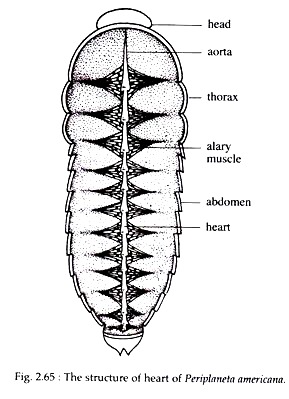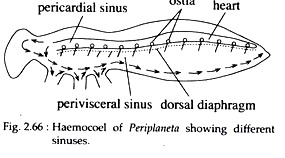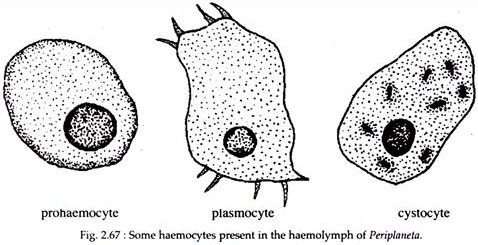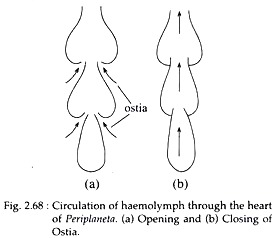In this article we will discuss about the Circulatory System in Cockroach:- 1. Subject Matter of Circulatory System in Cockroach 2. Circulating Fluid in Cockroach 3. Mechanism.
Subject Matter of Circulatory System in Cockroach:
Cockroach being an insect possesses an open circulatory system.
The system is poorly developed and consists of following organs:
Heart and Aorta:
ADVERTISEMENTS:
The heart of cockroach is an elongated contractile, narrow tube lying along the mid-dorsal line of thorax and abdomen just beneath the terga. The heart is enclosed in a pericardial sinus, the wall of which has segmented bundles of alary muscles and a dorsal fenestrated diaphragm.
The wall of the heart is composed of outer connective tissue and median muscle cells. The cavity of the heart is lined by the sarcolemma of median muscle cells. The heart consists of thirteen funnel-shaped and segmentally arranged chambers, each communicating by a valvular opening with that lying in front of it (Fig. 2.65).
The hinder end of each chamber has a pair of minute, lateral and valvular openings called ostia, which allows the flow of blood from the pericardium into the heart only and not in reverse direction. In each segment, heart sends a pair of ex-current arteries.
ADVERTISEMENTS:
The heart is closed behind but is continued forward as a short and narrow tube without ostia called the aorta. This aorta and segmental arteries finally open within the haemocoelic spaces.
Haemocoel:
The body cavity of cockroach is not a true coelom but a haemocoel containing blood (haemolymph).
The diaphragm or the dorsal fenestrated partition divides the haemocoel into three sinuses:
ADVERTISEMENTS:
(i) The dorsal or pericardial sinus surrounding the heart, aorta and alary muscles,
(ii) The middle or perivisceral sinus containing the alimentary canal (Fig. 2.66) and
(iii) The ventral sternal or perineural sinus enclosing the ventral nerve cord. It also extends into the legs as septa, dividing the cavity of each leg into two sinuses, one for the outward and the other for the inward flow of blood. The diaphragm being perforated, permits the blood to flow from one sinus into another.
Circulating Fluid in Cockroach:
Haemolymph:
In cockroach, the circulating fluid does not always flow through the vessels, rather comes in direct contact with the tissues while flowing in the haemocoel.
So the ‘blood’ of cockroach is both blood as well as lymph and is therefore, called haemolymph. It is colourless, as it lacks the respiratory pigment haemoglobin and does not take part in respiration. It consists of a clear fluid plasma in which are suspended nucleated cells or haemocytes.
The plasma contains various inorganic ions like sodium, potassium, calcium; organic compounds like, citrate; amino acids viz. alanine, cystine, glycine, tyrosine, valine etc.; enzymes like chitinase and glucosidase; carbohydrates; lipids and uric acid.
The plasma serves primarily as a means for:
ADVERTISEMENTS:
(i) Transportation of dissolved substances like food and wastes round the body,
(ii) Transmission of hydrostatic pressure from one end of the body to the other,
(iii) Reservoir of food as well as water and
(iv) It also helps in hatching of eggs, moulting and in expansion of wings.
Haemocytes:
The structure and function of the haemocytes of different insects including cockroach have been reviewed by different workers. However, the following haemocytes (Fig. 2.67) are most commonly present in cockroach haemolymph.
1. Prohaemocytes:
Small round cells with large nucleus and thin agranular cytoplasm. These cells divide to give rise to other kinds of haemocytes.
2. Plasmocytes:
Large amoeboid cells with pseudopodia, large nucleus and large mass of a granular cytoplasm.
3. Granulocytes:
Small to large cells with granular cytoplasm.
4. Cystocytes/Coagulocytes:
Cells with small nucleus and a pale hyaline cytoplasm with black granules (Fig. 2.67). The total number of cells in the haemolymph of adult Periplaneta is about 15,00,000 though the number obviously depends on the volume of haemolymph which is about 15.7-17.5 per cent of body weight. Haemocytes play significant role in the physiology and survival of cockroaches.
Their functions include:
(i) Phagocytosis of pathogens and tissue debris,
(ii) Encapsulation of metazoan parasites,
(iii) Detoxification of poisons,
(iv) Transport of growth hormones,
(v) Wound repair,
(vi) Formation of connective tissue and basement membrane,
(vii) Synthesis and storage of proteins, carbohydrates and
(viii) Coagulation of haemolymph.
Mechanism of Circulation in Cockroach:
The contraction of alary muscles enlarges the pericardial space so that the haemolymph flows into it from the underlying perivisceral sinus. When the alary muscles relax, the haemolymph is forced through the ostia into the heart. As the heart relaxes during diastole (Fig. 2.68) the tension of the ligament stretches out the walls of heart so that the haemolymph flows into the organs; anteriorly into the head.
It then passes back from the haemocoel of head into that of the thorax and abdomen and enters the pericardium. In addition to alary muscles, contraction of dorsal diaphragm also helps in rapid circulation of haemolymph. The heart beats at a rate of 100-200 per minute at 27°C. A complete cycle of circulation of haemolymph through the body takes 20-30 minutes.



